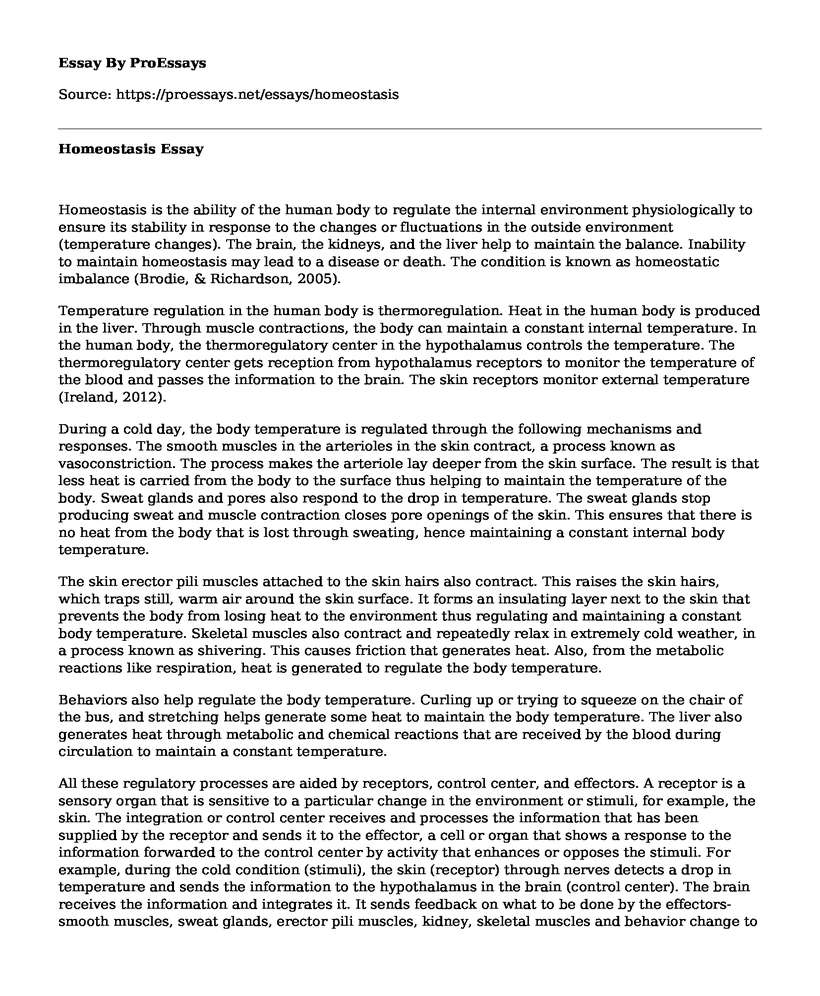Homeostasis is the ability of the human body to regulate the internal environment physiologically to ensure its stability in response to the changes or fluctuations in the outside environment (temperature changes). The brain, the kidneys, and the liver help to maintain the balance. Inability to maintain homeostasis may lead to a disease or death. The condition is known as homeostatic imbalance (Brodie, & Richardson, 2005).
Temperature regulation in the human body is thermoregulation. Heat in the human body is produced in the liver. Through muscle contractions, the body can maintain a constant internal temperature. In the human body, the thermoregulatory center in the hypothalamus controls the temperature. The thermoregulatory center gets reception from hypothalamus receptors to monitor the temperature of the blood and passes the information to the brain. The skin receptors monitor external temperature (Ireland, 2012).
During a cold day, the body temperature is regulated through the following mechanisms and responses. The smooth muscles in the arterioles in the skin contract, a process known as vasoconstriction. The process makes the arteriole lay deeper from the skin surface. The result is that less heat is carried from the body to the surface thus helping to maintain the temperature of the body. Sweat glands and pores also respond to the drop in temperature. The sweat glands stop producing sweat and muscle contraction closes pore openings of the skin. This ensures that there is no heat from the body that is lost through sweating, hence maintaining a constant internal body temperature.
The skin erector pili muscles attached to the skin hairs also contract. This raises the skin hairs, which traps still, warm air around the skin surface. It forms an insulating layer next to the skin that prevents the body from losing heat to the environment thus regulating and maintaining a constant body temperature. Skeletal muscles also contract and repeatedly relax in extremely cold weather, in a process known as shivering. This causes friction that generates heat. Also, from the metabolic reactions like respiration, heat is generated to regulate the body temperature.
Behaviors also help regulate the body temperature. Curling up or trying to squeeze on the chair of the bus, and stretching helps generate some heat to maintain the body temperature. The liver also generates heat through metabolic and chemical reactions that are received by the blood during circulation to maintain a constant temperature.
All these regulatory processes are aided by receptors, control center, and effectors. A receptor is a sensory organ that is sensitive to a particular change in the environment or stimuli, for example, the skin. The integration or control center receives and processes the information that has been supplied by the receptor and sends it to the effector, a cell or organ that shows a response to the information forwarded to the control center by activity that enhances or opposes the stimuli. For example, during the cold condition (stimuli), the skin (receptor) through nerves detects a drop in temperature and sends the information to the hypothalamus in the brain (control center). The brain receives the information and integrates it. It sends feedback on what to be done by the effectors- smooth muscles, sweat glands, erector pili muscles, kidney, skeletal muscles and behavior change to counter the drop in temperature (Ireland, 2012).
This is a negative feedback mechanism. It corrects a drop in temperature to normal. Since the temperature has dropped, it has to be controlled to normal by increasing the temperature by the above processes.
References
Brodie, M., & Richardson, M. (2005). Homeostasis. Hatfield: University of Hertfordshire Press.
Ireland, K. (2012). Visualizing human biology. (4th ed.). Danvers, MA: Wiley. ISBN: 9781118169872
Cite this page
Homeostasis. (2021, Mar 13). Retrieved from https://proessays.net/essays/homeostasis
If you are the original author of this essay and no longer wish to have it published on the ProEssays website, please click below to request its removal:
- The Human vs/as the Animal
- Anatomy and Physiology: Speech Language Pathology Paper Example
- The Various Functions of Hormones in a Living Organism - Research Paper
- Essay Sample on California's Weather: Planning Ahead for Extreme Conditions
- Paper Example on Sharks & Teleosts: Similarities & Differences
- Essay Sample on 3 Sections of the Brain: Cerebrum, Brain Stem, & Cranial Nerves
- Melting Point: Key to Substance Purity & Identification - Paper Sample







